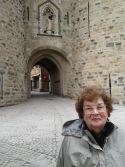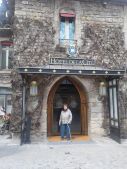 Carolyn’s other bucket list stop on this trip was the medieval fortress at Carcassonne, the best preserved (or perhaps restored) architectural gem of its kind in Europe.
Carolyn’s other bucket list stop on this trip was the medieval fortress at Carcassonne, the best preserved (or perhaps restored) architectural gem of its kind in Europe.
It’s no wonder it was important as long ago as Roman times (typically, the Romans founded the locations for what are now the great cities of Europe). It’s on a hilltop overlooking a river valley, in sight of the Pyrenees (another important dimension), and on the trade route from the Atlantic to the Mediterranean.
The Roman garrison built the first wall in the 4th century A.D., which did not spare the city from being conquered by the Visigoths, initiating a millennium in which warfare played a role in defining the city.
One major incursion apparently gave it its name. It was ruled briefly by the Saracens, including the cagey wife of Bulcak, Lady Carcas. According to legend, when Charlemagne besieged the city, she propped up dummies at the ramparts to trick Charlemagne into thinking the city had more defenders than it did. Then she fed the last pig the last remaining grain and threw it over the wall, and Charlemagne was supposedly convinced the city could not be taken, and called off the siege; the city has since been known as Carcassonne.
Another highlight occurred in the 13th century, when the viscount was one of the staunchest supporters of an early effort to reform the Catholic church. The Charthars, Albigensians, rejected the authority of the Pope. In 1209, one of the Pope’s crusading armies swooped down and conquered Carcassonne under Simon de Montfort, whose ruthless Catholicism had originally taken him on the fourth crusade (the one that detoured from Jerusalem to Constantinople); he left it when the Crusaders plundered the Christian city of Zara. He came back to France and took up arms against the Albigensians.
Shortly thereafter, the victor transferred the city to the King of France, who built its second wall and reinforced a number of its towers, creating an imposing fortress that was then on the boundary with the Kingdom of Aragon. Added were the trappings of castles: the barbican, a curved wall in front, and hoardings, a temporary wooden platform to enable archers to shoot directly downward, and death holes (we learned a lot of vocabulary today). It had 52 towers.

 In the mid-19th century, Viollet de Luc, an archeologist interested in medieval restoration (Notre Dame was one of his projects), made the restoration of the fortress one of his major goals. He was hampered somewhat because the archives had burned down, leaving only one portrait of what the old city had looked like. He recreated the city of Louis IX, in the thirteenth century, a task which took 50 years. His first renovation was of the church, an interesting combination of Romanesque (early) and Gothic (under the King); interestingly, it was the discovery of the tomb of one of the early bishops in the church that inspired Monsieur Violett le Luc.
In the mid-19th century, Viollet de Luc, an archeologist interested in medieval restoration (Notre Dame was one of his projects), made the restoration of the fortress one of his major goals. He was hampered somewhat because the archives had burned down, leaving only one portrait of what the old city had looked like. He recreated the city of Louis IX, in the thirteenth century, a task which took 50 years. His first renovation was of the church, an interesting combination of Romanesque (early) and Gothic (under the King); interestingly, it was the discovery of the tomb of one of the early bishops in the church that inspired Monsieur Violett le Luc.

 Parts of the city have since been changed—for example, some of the towers have been restored to appear as they might have been built by Visigoths; part of the Roman wall is still there, marked by smaller bricks, and a row of red bricks so the builders could level the tower. There’s also a statue to the long time Maire, he who brought water to the hilltop. Our guide told us that probably no more than 50 people live in the city today (“You have to get to the supermarket in the lower city before 9, and back before the tour buses get here,” she stated), but nearly 4 million visitors come here every year.
Parts of the city have since been changed—for example, some of the towers have been restored to appear as they might have been built by Visigoths; part of the Roman wall is still there, marked by smaller bricks, and a row of red bricks so the builders could level the tower. There’s also a statue to the long time Maire, he who brought water to the hilltop. Our guide told us that probably no more than 50 people live in the city today (“You have to get to the supermarket in the lower city before 9, and back before the tour buses get here,” she stated), but nearly 4 million visitors come here every year.
We’re lucky it’s relatively quiet now, and my lady and I can really enjoy our two nights (and one knight) in the 13th century. It’s much easier based in our 5 star hotel!
